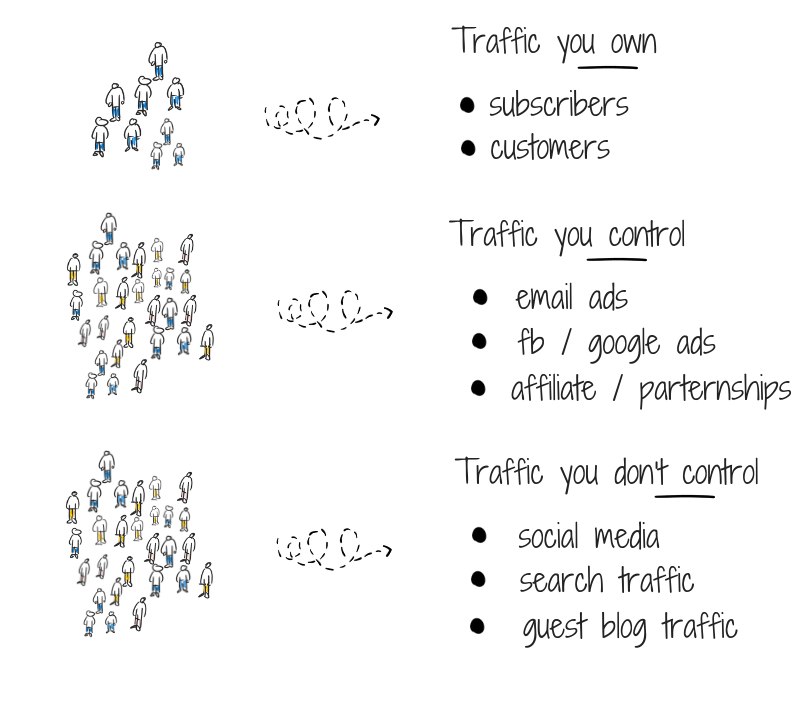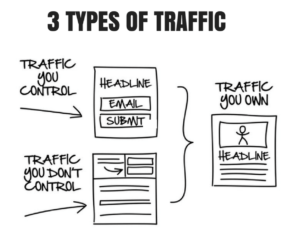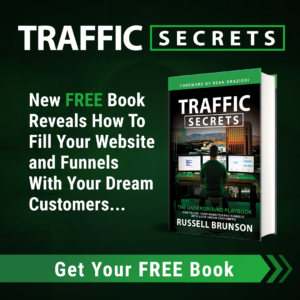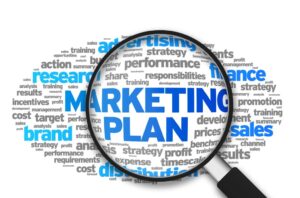Traffic is the lifeblood of any business. It doesn’t matter if you have the best looking website, sales page, or sales funnel in the world – without traffic you won’t be in business for very long.
Having a steady stream of traffic to your website, opt-in pages, offers, and webinars is every internet marketer’s dream, but internet traffic can be a daunting subject to understand.
There’s so much traffic out there – traffic from blogs, forums, YouTube, social media, paid advertising, SEO, etc. It can be daunting to try to understand each traffic source and how to get that traffic to where you want.
Thankfully there’s a much easier way to think about traffic, and when you understand this lesson it’ll make the subject of internet traffic a lot less intimidating.
In this post, I’ll go through what I learned from internet marketer Russell Brunson about the three types of traffic. If you don’t know Russell Brunson, he is the founder of the popular funnel-building software ClickFunnels, and is a huge influencer in the online marketing world.
He has written a series of online marketing books called:
DotCom Secrets, Expert Secrets, and Traffic Secrets.
If you haven’t read them I can highly recommend you buy them because the information Russell shares is priceless. You can currently pick up the books for free – you only have to pay for the shipping and handling. Click on the links above to get your copies now.
What are the three types of traffic?
In the DotCom Secrets and Traffic Secrets books Russell talks about there only being 3 types of internet traffic.
1. Traffic you earn / Traffic you don’t control
2. Traffic you control
3. Traffic you own

Regardless of what specific platform or channel that traffic has come from it can be classified as one of these three types.
Let’s take a closer look at each traffic type.
1. Traffic you earn / Traffic you don’t control
Note: The first book Russell Brunson released was DotCom Secrets, and when he released that book he called this type of traffic “Traffic you don’t control”. In his latest book Traffic Secrets, he has amended the name and now calls it “Traffic you earn”. They are both referring to the same traffic type, but for clarity purposes, I have listed both names down to avoid any confusion.
Traffic you earn/don’t control is normally traffic that has found you via organic means – this could be through the search engines, or a Facebook page, a blog post, or even word of mouth.
You don’t have control over this type of traffic. This traffic normally just shows up and you can’t really control where it came from or where it goes.
Example: If someone mentions your website on their Facebook page, one of their followers may visit your website and land on some random page on your blog. You have no control over that sequence of events, hence why Russell Brunson initially called it “traffic you don’t control”.
Russell also refers to this type of traffic as “earned traffic” because you will have to put in the work to earn this type of traffic – writing a blog post takes effort, so does posting regularly on your social media platforms, or getting ranked for certain search terms on Google.
2. Traffic you control
You control traffic when you have the ability to tell it where to go. This is traffic that is generated via any sort of paid advertising such as Facebook ads, Google Ads, banner ads, video ads, solo ads, etc.
If you use any of these ad platforms such as Google, you don’t own the traffic – Google does, but you control it by directing it to where you want it to go. This type of traffic is a lot more manageable than the traffic you don’t control, and you can predict the amount of traffic you can generate by looking at your analytics data.
If you want more of this type of traffic you will have to increase your advertising budget and be willing to spend more.
3. Traffic you own
This is the holy grail of traffic.
Traffic you own is any sort of traffic of which you are in full control. This consists of your email lists, followers, fans, subscribers, existing customers, etc.
This is called “Traffic you own” because you can send out an email to your list or post something on your social media page and generate instant traffic that you can control and direct to wherever you want. You don’t have to spend any more money to get this traffic – you own it, and you have permission to market and communicate with this type of traffic.
When you have a list of customers, subscribers, followers, etc. you have your own ready-made audience that you can reach out to at any time to direct them to an offer, blog post, or sales funnel.
This is why the following statement still holds true for marketers today:
“The money is in the list”
Your list refers to any traffic you own.
Your goal as a marketer is to convert traffic you earn/don’t control, and traffic you control into traffic you own. Once you own that traffic you have a targeted audience of people who know you, and who are more likely to buy from you compared to the other two types of traffic.
Convert all traffic into traffic you own
In order to convert traffic you earn/don’t control, and traffic you control into traffic you own, you need two things:
- Their contact information
- Their permission to be contacted

You can obtain these two things by directing both traffic sources to an opt-in page or squeeze page where you offer some sort of lead magnet or free product in exchange for their email address and permission to contact them.
As both types of traffic are different you will have to go about this in a slightly different way for each type.
Converting traffic you don’t control into traffic you own
As you don’t control this traffic type you can’t directly lead them to your opt-in page, so the best way to get their contact details or permission is to have an opt-in form highly visible on all pages of your website to make it more noticeable.
This means if a random person does a search and your blog comes up on the Google search results and they click through to your site, they should see the opt-in form on whatever page they land on.
You can’t control whether or not they decide to opt-in but you can make it easier by making your opt-in offer highly visible and by offering something they will want. You should have the opt-in form on your homepage so it’s nice and visible and also have it as a side banner so that it is visible on all pages. You can also use a pop-up form that will ensure that all visitors see your opt-in offer, regardless of what page they land on.
Your opt-in offer could be for a free report, e-book, or to join your newsletter. Regardless of what your lead magnet is, you have to offer them something of perceived value in exchange for their email address and contact information. Read our article for more information on the qualities that all lead magnets should have.
Converting traffic you control into traffic you own
This is a lot easier as you are in direct control of where this traffic ends up.
When someone clicks on your ad you should direct them to your opt-in form or squeeze page where they will be presented with the offer of your lead magnet (free ebook, report etc.) in exchange for their contact information. Once they have opted-in they are now on your list and have become traffic you own.
You can now reach out to the people on your list whenever you like, and direct them to wherever you want such as an offer, webinar, blog posts, etc.
The importance of list building
Converting all types of traffic into traffic you own is the key to building your list, which is your greatest asset as a marketer.
If you use any social media platform and have a number of followers and subscribers on those platforms, it’s important that you also have their email addresses and other contact information so you can contact them outside of those platforms via email, direct mail, SMS, etc. The reason is simple – those platforms can shut you down anytime.
If you have a successful YouTube channel with millions of subscribers, what would happen to your business if YouTube banned your channel tomorrow? This is not totally out of the question and has happened to many people whose channels were banned for some reason or other. The same thing also applies to Facebook, Google, and any other platform you may be using to build and communicate with your audience.
If you solely rely on traffic from SEO and Google, what would happen if Google changed their algorithm tomorrow and your 1st-page rankings suddenly dropped to page 10? How much traffic would you lose, and how would your business be affected as a result?
These things have happened time and time again to countless different business owners and internet marketers. Just do a quick search on how Google updates have affected search ranking – there are literally hundreds of stories of people losing their businesses overnight after a Google algorithm update caused their traffic to disappear.
This happened because those people didn’t own their traffic or lists. Facebook owns your fans, YouTube owns your subscribers, and Google owns any traffic it sends you via its search engine.
If you rely solely on these platforms you are effectively putting your business in the hands of those companies and are at the mercy of algorithm changes, policy changes, or whatever else they decide to do.
But if you turn that traffic into traffic you own and build your own lists you don’t have to worry about losing your presence on those platforms because you have a direct source of traffic that you own and can reach out to anytime. When you do that you will be building a business that is truly sustainable and is not at the mercy of any one platform or company.
This is why it is essential that you start to convert any traffic you don’t control and traffic you control into traffic you own.
Get the Traffic Secrets book free
If you have found these ideas interesting and want to learn more about traffic, I can highly recommend you get Russell Brunson’s books.
I recommend you read all of them but if you want to learn how to get more traffic from a variety of different channels such as Instagram, Google, Facebook, SEO, etc., and how to turn that into traffic you own, then you need to check out the Traffic Secrets book.
The book goes into a lot more detail on traffic, building your list, building a sales funnel, and how to structure your offers.
You can get the Traffic Secrets book completely free, all you have to do is cover the shipping.




